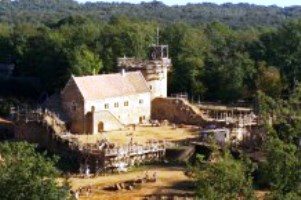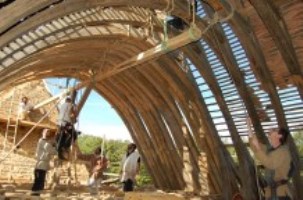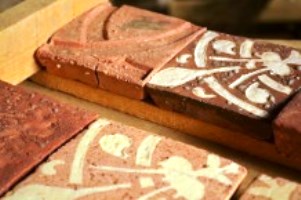Guédelon: A Castle in the Making (2011) by Maryline Martin & Florian Renucci

In Yonne, Burgundy, a unique construction site is creating a genuine fortified chateau of yesteryear. Starting in 1997, completion date is scheduled for 2022. At first sight, the men are grinning, and completely crazy. Dressed in authentic homespun clothing, and working in a quarry in the depths of the dense forest, this could be a film-set, but they are recreating the year 1246, in the reign of Louis IX of France.
This outstanding ‘Living History’ project was inspired by Michel Guyot, who owns the nearby Chateau de Saint-Fargeau, and had the idea of building a 13th-century style fortress following the discovery that the 15th-century red bricks of his castle obscured the stone walls of a much older stronghold.
He had a passion for recreating medieval displays on a grand scale, so naturally, the next challenge had to be to recreate the entire thirteenth century chateau complete with authentic equipment, and built as near as humanly possible in the same manner and technique of the time.
The site – in the heart of Guédelon forest – was found; a site which offered not only all the resources required for building a castle – a stone quarry, an oak forest and a water supply – but in sufficient quantities to satisfy the demands of this gigantic site. The first team started work and on June 20th 1997 the first stone was laid.
Out of the wood, clay and stone, quarrymen, stonemasons, woodcutters, carpenters, blacksmiths, tile makers, basket makers, rope makers, carters and their horses are working together, many volunteers and craftsmen donating their labour to share the experience.
The task is to recreate the construction techniques and the logistical organisation of an early 13th-century building site. The work is based on medieval financial records, illustrations on illuminated manuscripts, cathedral stained-glass windows and the evidence of contemporary chroniclers. These sources provide us with an insight into the tools used and the building techniques employed. However, in order to ensure that working practices match, as closely as possible, that of the 13th-century, the project’s founders and the master mason closely examined a number of existing castles.
These 13th-century castles are the last reliable witnesses left to us by history. Once examined, photographed and measured, their evidence avoids committing unnecessary errors which would later need correcting. This way of working has allowed the project to reveal some of the medieval castle builders’ fascinating secrets. Ratilly, La Motte-Josserand, Dourdan and Yèvre-le-Châtel are among the castles which serve as models.
The historical context
Guédelon has adopted a specific historical time-frame. The start date for the castle’s construction is taken as 1229. Louis IX, the future Saint Louis, was crowned in Reims three years earlier in 1226; Loius being too young to rule, his mother, Blanche of Castile, acted as Regent until 1235.
Locally, Puisaye was under the control of Jean de Toucy. To the south-east lies the county of Auxerre-Nevers, controlled by Mahaut de Courtenay; in the north, the Capetian lands of Gâtinais. On the eve of the sixth crusade, Puisaye is enjoying a period of relative peace and stability.
The architectural context
The future castle of Guédelon is an entirely new construction; there are no vestiges of a former castle in or around the site. The castle’s design is based on the architectural canons laid down by Philip Augustus in the 12th and 13th centuries.
Philip II Augustus, King of France from 1180-1223, is attributed with standardising the military architecture of castles in the French kingdom. Examples of this standard plan include the Louvre in Paris, Yévre-le-Châtel castle in Loiret, or more locally, the castles of Ratilly or Druyes-les-Belles-Fontaines in Yonne.
Castles built to this standard plan have the following characteristics: a polygonal ground plan; high stone curtain walls, often built on battered plinths; a dry ditch; round flanking towers pierced with single embrasured arrow loops, the position of which is staggered on each floor of the tower; one corner tower, higher and larger than the rest, known in French as the tour maîtresse, and the twin drum towers that protect the gate.
During his reign, Philip Augustus established – by way of treaties, alliances and politically advantageous marriages – a long-term Capetian policy of expansion, this fact justifies the choice of a French, as opposed to a Burgundian, architectural model in this particular part of France.
The social context
The man that they imagined to have ordered the castle’s construction, Guilbert, would have been a low-ranking nobleman, vassal to Jean of Toucy, who in turn was vassal to the king of France. Having obtained leave to build his castle, and owing to his modest standing in the feudal hierarchy and his limited finances, Guilbert favours building a small castle, a fortified residence, far removed from the scale of royal castles like the Louvre or Brie-Comte-Robert in Seine-et-Marne.
Today, Guédelon employs some 50 people, of whom 35 work on the building site itself. Some were already qualified, but others have acquired their skills on site; however, at Guédelon, the ability to communicate with the visiting public is just as important as mastering a craft.
Simple things easily taken for granted surprise visitors, for example, the sound quality. Most building sites generate lots of noise from machinery etc. but here you have the thump of the sledgehammer on a rock, the squeak of a cartwheel, a saw cutting wood and the laughter of a shared joke. They do laugh, not least of all because they are working in a manner so alien to modern working practices, and they are re-experiencing the joy of craftsmanship.
Each year, around 700 people choose to play an active role in the venture. From a wide range of backgrounds – skilled craftsman, castle enthusiasts, complete novices eager to learn, or work-experience students – they all come in order to learn more about the building techniques used on site. For a period of several days, they step into the shoes of a medieval builder.
Local journalist Thierry Darques, who usually works on the local paper, L’Yonne Republicaine, put away his pen for a new career as a craftsman edge-tool maker, working his forge from spring to autumn, but still occasionally contributes an article or two for his paper, however “because of my work at the anvil, I have a tendency to bust my keyboard..”
Clement is in charge of the stone cutters and loves the work he is doing on a construction project totally unlike any modern counterpart, but as he says, “We are building a dream, though our feet are firmly on the ground”. As a craftsman he made the choice to wear authentic mediaeval clothing, with one concession, modern safety footwear. At the beginning of the project, Clement worked with disadvantaged young people. “Initially we had to go and wake them up when it was time for work, but now many of them are trained craftsmen, and we have to kick them off the site to make sure they take a break!”
Eric and Joel quarry, cut up and deliver the blocks of the red-veined local stone to the masons (known in the 13th century as wall-toads). The two young men have been working on this project from the beginning, seeing it as a marvellous human experience, and taking pride in not ‘cheating’ by using modern techniques.
Everything is measured with a string with thirteen knots, and the units of measurement are palms, spans and cubits. As for hours, terms and conditions, they laugh. They still have nine years to go.
A crossbow shot away, the masterpiece is rising from the soil. The curtain walls, the postern, the fixed bridge, the rib-vaulted guard rooms, the groin-vaulted cellar, the roof timbers, and the lord’s chamber have all been built in front of the thousands of visitors who have flocked from across the globe to see the only construction site of its kind.
The site is overseen by the master mason: Florian Renucci. He is responsible for the day-to-day running of the site and, along with the project’s managers, ensures that the work carried out is historically, architecturally and archaeologically accurate.
In 2012, the quarrymen, stonemasons and carpenters completed the lord’s chamber on the first floor of the great tower and began work on the next level. Construction of the domed vault in the eastern corner tower has been completed, as well as the paving of the great hall and antechamber, with floor tiles made and fired on site.
It is impossible to visit castles and cathedrals of the Middle Ages without wondering how these buildings were constructed, where the materials came from, how they were transported, which tools were used or how such heavy loads were hoisted. Guédelon sheds light on these mysteries of the medieval world.
At a time when environmental protection is of such concern, Guédelon provides practical lessons in sustainable building. This pioneering construction site offers information skills such as making wattle and daub, building rubble walling, using lime-based mortar, firing terracotta roof tiles, cleaving oak shingles, making flax and hemp ropes. Inspired by the past, this building site is also very much of relevance to the 21stcentury.
Every day, the site attempts to resolve many questions still unanswered by historians and archaeologists. The nature of the project demands the involvement of academics, and the work is monitored by both archaeologists and historians. Their involvement is of mutual benefit; they provide the project with invaluable information, while in turn, they have the unique opportunity to observe a team of builders at work on a medieval building site. They can study the skills needed, how tools are handled, and how the site is organised.
Unlike almost any present-day building site, members of the public are actively encouraged to observe the work in progress. The workers’ role is to demonstrate and explain, to a diverse audience, traditional skills. Stone quarrying, the building of vaulted ceilings, the blacksmiths’ work and the assembling of roof timbers, and the making of clay tiles are just some of the activities that visitors can witness at first hand during a visit to Guédelon. The workers are always on hand to talk about their craft and the progress of the castle.
Each year, 60,000 school children visit Guédelon. The site is an excellent educational resource, bringing to life the history of the Middle Ages. In the heart of an area of outstanding natural beauty, this ever-changing site can be visited time and time again. Many visitors are intensely loyal and regularly return to follow the construction’s progress. In 2011, Guédelon welcomed more than 310,000 visitors, including a large number of overseas visitors.
In conclusion, apart from creating what amounts to a work of art, the project demonstrates what can be achieved by co-operation, and helps us to reflect on the contrast between the working methods of today and yesterday. Some of the advantages of today have not outstripped the past, we can still learn from the 13th century.
Thanks to:
Guédelon’s official site. Guédelon: a castle in the making.
The Living History Digest Vol 19, No 1
Panoramic views of the site :





